Home »
Production of commercial vehicles in the UK declined by 2.9% in the first half of the year, according to the latest data from the Society of Motor Manufacturers and Traders (SMMT).
A total of 56,956 vans, trucks, taxis, buses and coaches rolled off production lines between January and June, compared to the same period in 2023.
The SMMT attributed the decrease to a slowdown following a strong performance last year as the automotive industry recovered from the pandemic.
Despite the decline, overall production remains significantly higher than pre-pandemic levels, driven by increased export demand and investment in new models and technologies.
Overseas shipments of UK-built commercial vehicles rose by 3.6% to 39,168 units in the first half of the year, with the European Union accounting for the majority of exports.
However, the domestic market contracted by 14.8% over the same period.
Mike Hawes, SMMT Chief Executive, said, “While a decline in output is always disappointing, some normalisation following the CV sector’s rapid post-pandemic recovery was expected. The sector remains in good health with strong global demand for high quality British-built CVs and plants ramping up EV production to meet current and future needs. However, the sector will not rest on its laurels and will work with the new government to deliver the favourable industrial, trade and market conditions that are essential if manufacturers are to drive economic growth and decarbonisation in every part of the country.”
Industry forecasts predict a gradual increase in commercial vehicle production in the coming years, with the potential to exceed 130,000 units by 2030.
Recent figures, also released by the SMMT, show that For continues to lead the way for van registrations with the Ford Transit Custom maintaining its position as the most popular van on sale in Britain today. Ford also occupies second position with the Ford Transit large van and the Ford Ranger pick-up truck the third most popular commerical vehicle on British roads.
The year-to-date market figures also show that registrations of new BEV vans is down 0.5% compared to last year. So far registrations are at 4.7%, compared to 5.2% last year.
Orders are now open for the Renault Trafic E-Tech, the medium-sized electric van, with prices starting from £34,500 plus VAT (after the government's Plug-in Van Grant). First deliveries are expected in September 2024, giving businesses a zero-emission option for their fleets.
See our list of the best medium electric vans
The Trafic E-Tech comes in three body styles, including a high-roof version that provides additional cargo space. It joins Renault's existing electric van range, offering a suitable electric option for businesses of all sizes.
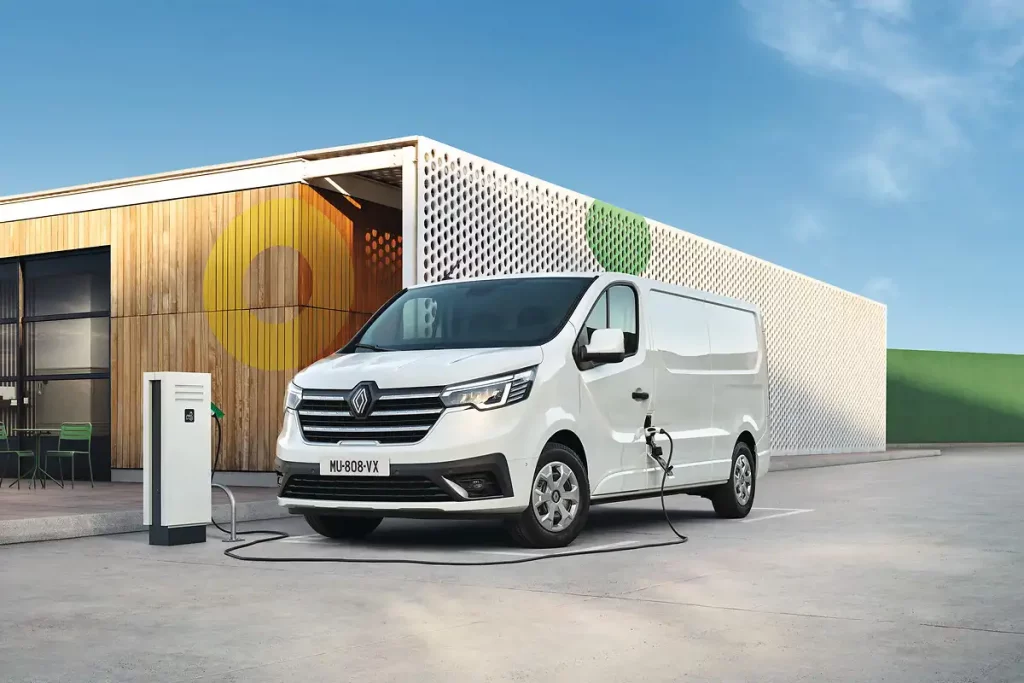
The new electric Trafic offers two body lengths and two roof heights, providing a cargo capacity range of 5.8 cubic metres to 8.9 cubic metres.
The long-wheelbase version can accommodate loads up to 4.15m long and a maximum payload of 1222kg. The Renault Trafic E-Tech also have a towing capacity of up to 920kg.
Inside the cabin, there's up to 88-litres of storage space with a "mobile office" feature that provides a dedicated workspace within the van.
With a 52kWh battery, the Trafic E-Tech has a WLTP-rated driving range of up to 186 miles on a single charge. The battery can be fast-charged using a 50kW DC charger, which can charge the battery from empty to full in around an hour.
The Trafic E-Tech comes with an 8-inch touchscreen infotainment system with smartphone compatibility at standard, as well as LED headlights, electric mirrors, parking sensors, cruise control, and numerous other safety features.
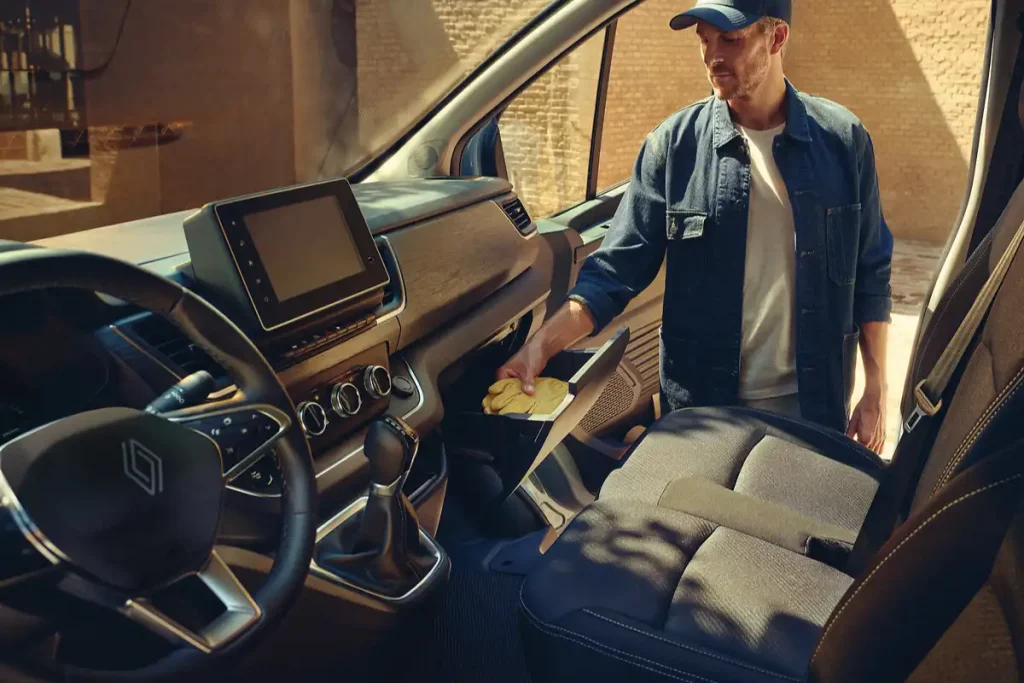
There's also a height-adjustable driver's seat and air conditioningm while options include climate control, heated seats, a 360-degree parking camera, and various other advanced driver assistance systems.
| MODEL | BASIC PRICE | VAT | RETAIL PRICE | PiVG | BASIC PRICE AFTER PiVG | RETAIL AFTER PiVG | OTR CHARGES | OTR AFTER PiVG |
| SL30 E-Tech Advance | £39,500 | £7,900 | £47,000 | £5,000 | £34,500 | £42,400 | £755 | £43,155 |
| LL30 E-Tech Advance | £40,250 | £8,050 | £48,300 | £5,000 | £35,250 | £43,300 | £755 | £44,055 |
| LH30 E-Tech Advance | £41,250 | £8,250 | £49,500 | £5,000 | £36,250 | £44,500 | £755 | £45,255 |
It's been 70 years since the Volkswagen Transporter first arrived in the UK, making it's public debut at the Commercial Motor Show at Earl's Court, in 1954.
Six generations later, the Transporter is now about to get its seventh generation when it is revealed at the IAA Hannover trade show in September. The newest version will share a platform with the Ford Transit Custom - the first time the VW Transporter has paired up with a partner.
It will get distinctive Volkswagen styling on the inside and out, but will share the same range of engines inlcuding plug-in hybrid and a full battery electric vehicle version.
Since first arriving, the Transporter has sold more than 13 million units across the world and has grown from just 786 UK sales in 1954, to a whopping 17,521 in 2023.
The most recent update was to the Volkswagen Transporter T6.1, launched in 2019, which got a new dashboard, improved connectivity and under went a facelift with updated headlights and grille.
Here's a brief history of the rest of the VW Transporter range.
T1: 1950 to 1967
Revealed as a hand-built panel van prototype in 1949, the T1 eventually launched as a rear-engine panel van, passenger van and eight-seat vehicle. The engine and gearbox came from the Volkswagen Beetle and it offered a maximum payload of 750kg. In 1951, the iconic "Samba" model was revealed with all-round windows and folding sunroof, and a year later a pick-up version was unveiled. Production moved from Wolfsburg to Hanover in 1956, with some models built in Brazil. By 1967, around 1.9 million people had purchased the T1 with its "splittie" windscreen, making it a global success.
T2: 1967 to 1979
With the T1 forging its name as something of a cultural icon during the swinging sixties era, the successor had a lot to live up to. The T2 took the design and utility of the van forward with a new front end and air intake grille. A sliding door was now standard, and the pop-up roof camper version became an instant hit with globetrotters. In 1972, the T2 went electric with a zero-emission version available to buy. During its run, 2.14 million vehicles were built at the Hanover plant. Production continued until 2013 at the Volkswagen plant in Sao Paulo.
T3: 1979 to 1992
The T3 took the famous vehicle into the modern era with a wider body offering, more passenger and cargo space and improved safety. A flat engine, available in diesel, was introduced adding to the spaciousness while a new chassis offered car-like handling. In 1985, a raft of innovations were added: catalytic converters, turbochargers and all-wheel drive, while the California and Caravelle became popular. In total, 1.3 million T3s were made in Hanover.
T4: 1990 to 2003
This generation marked a technical revolution with Volkswagen Commercial Vehicles making the T4 front-engine and front-wheel drive for the first time. With this came a new design, longer front end, new suspension, more varied engine choice and even better handling. The Transporter was also available in two wheelbases for the first time. Following a 1996 mid-model refresh, the T4 was phased out in 2003 having sold 1.9 million models across the range, which had grown to feature the panel van, kombi, double cab, pickup and chassis with single and double cab, Caravelle, Multivan and California.
T5: 2003 to 2015
The T5 was an evolution of exterior design with greater focus placed on the interior and the driver's workplace as well as a variety of petrol and diesel engines and an all-wheel drive system. The California was built in Hanover for the first time, while Caravelle and Multivan continued to be popular choices alongside a number of limited-edition models. In total, 1.65 million T5s were produced.
T6 / T6.1: 2015 to 2019 / 2019 to present
New engines, intelligent driver assistance systems, new infotainment and a front-end redesign have defined the modern T6 era - while the two-tone paint scheme serves as a nod to the original model. In 2019, Volkswagen Commercial Vehicles brought the iconic van into the digital age with a new dashboard design, a raft of technology and connectivity updates as well as a new power steering system and additional efficient, clean turbodiesels.
Citroen has released a new add-on for the Ami enabling anyone to convert their existing vehicle into a van.
When the Citroen Ami was first launched it the commercial vehicle version was a specific option on the price list. The Citroen Ami Cargo got a separate plastic partition instead of the passenger seat.
Now, Citroen has added a new commercial vehicle (or Ami Cargo) option pack to convert your existing Citroen Ami two-seater passenger car into an Ami electric van.
The new My Ami Cargo Kit module is offered as a retrofit accessory, replacing the Citroen My Ami Cargo version on the price list.
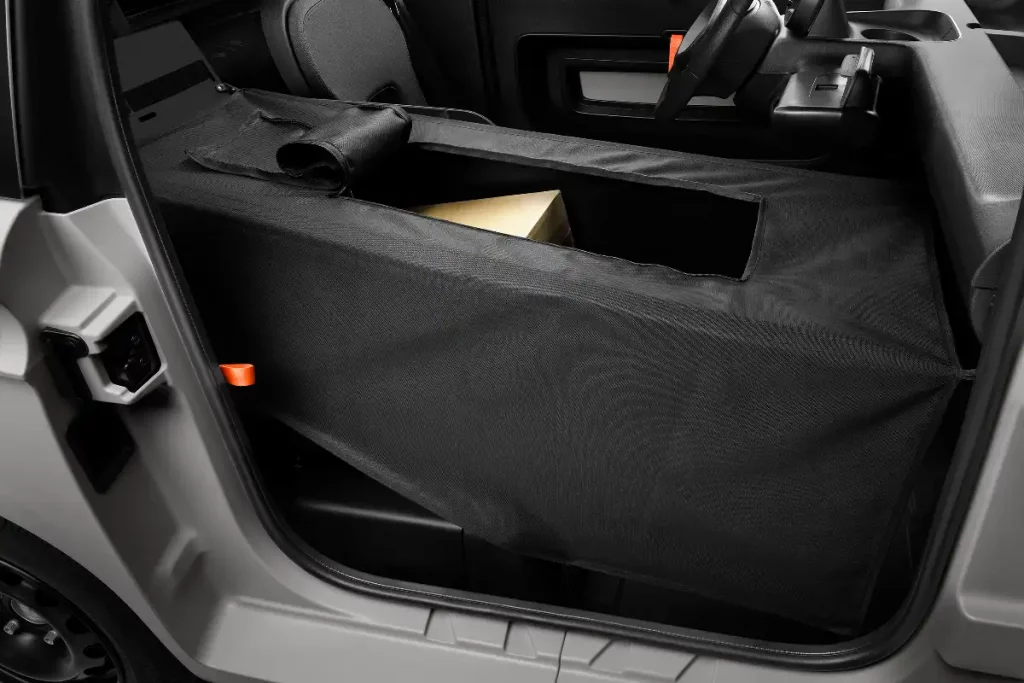
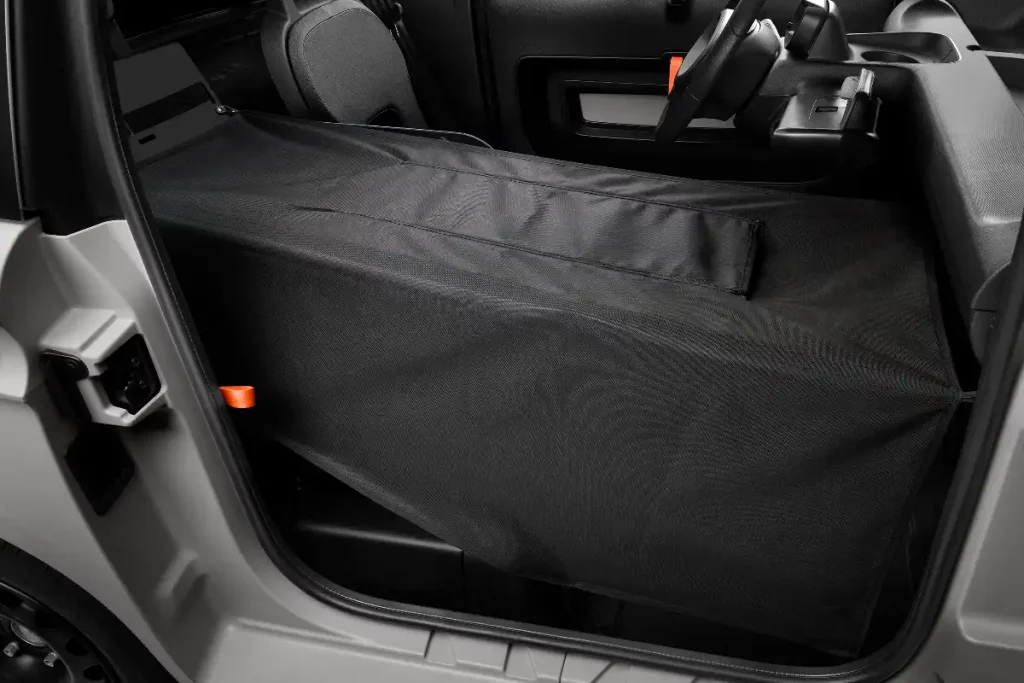
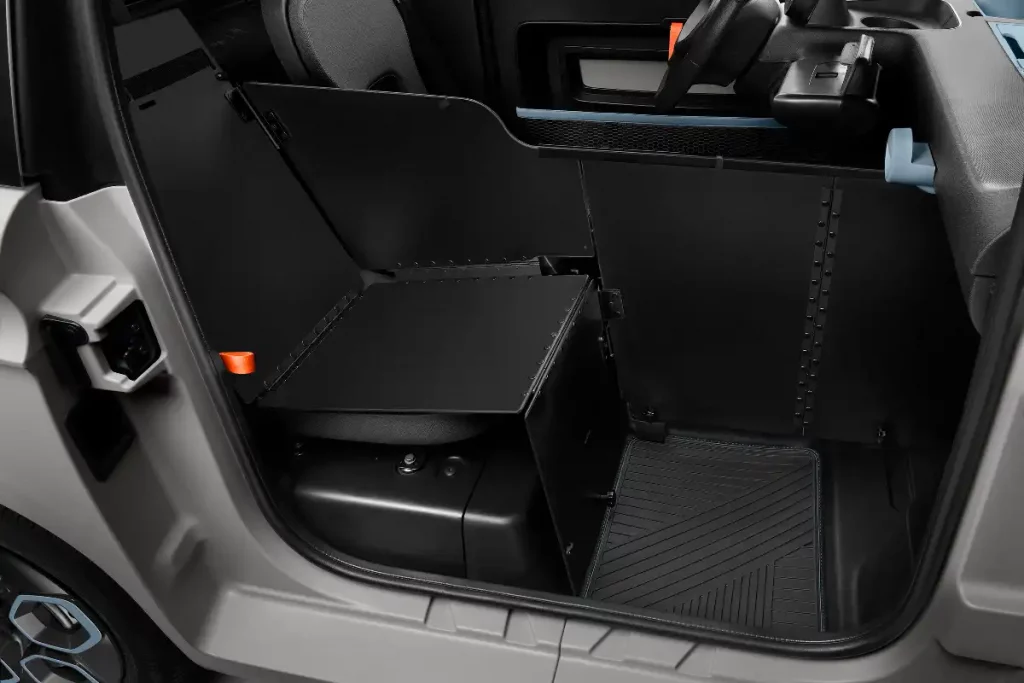
It’s now possible to switch the Ami into a cargo configuration (or back) in just five minutes.
The new Cargo van kit protects the second seat with two vertical panels to separate driver and passenger areas and four additional panels to create a practical loading surface. Items can be secured under a restraining net.
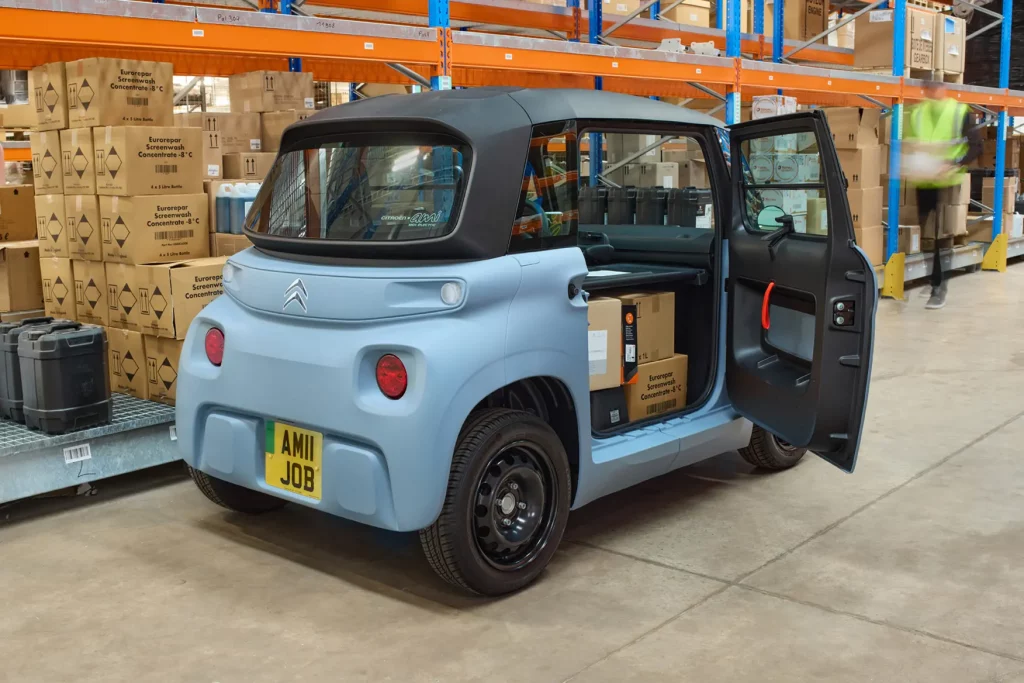
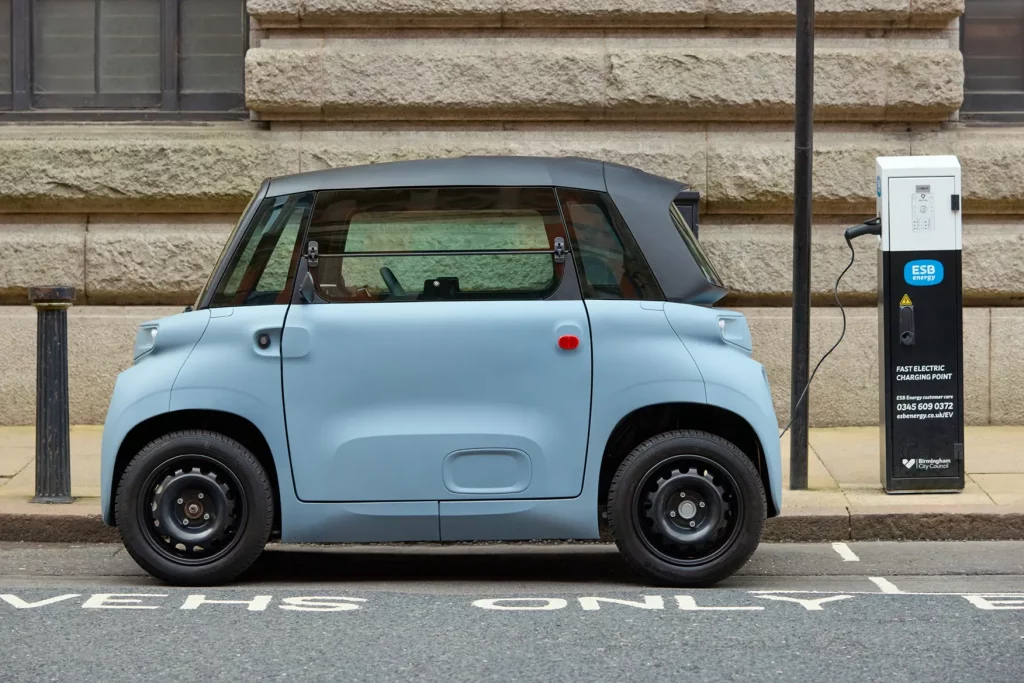
Citroen says the kit supports up to 200 litres under the net and has a total volume of 340 litres.
All of the Ami Cargo conversion kit also can be folded and stored behind the driver’s seat. That will allow you to quickly revert back to a two seater passenger car should you need.
The My Ami Cargo Kit is available to order immediately from the Citroën Online Store or from the Citroën retailer network priced at £259 (inc VAT).
Also relaunched is a new version of the regular Ami.
The range will now get a high-end My Ami Peps model that adds the 'best bits' from the Pop and Tonic models.
The Ami range will now start with the entry-level Ami and mid-range My Ami Orange, Grey, or Blue, finishing with the My Ami Peps which gets a black graphic band with yellow decals, black headlight rims, a rear spoiler, wheel covers, rear quarter graphics, and lower door decals.
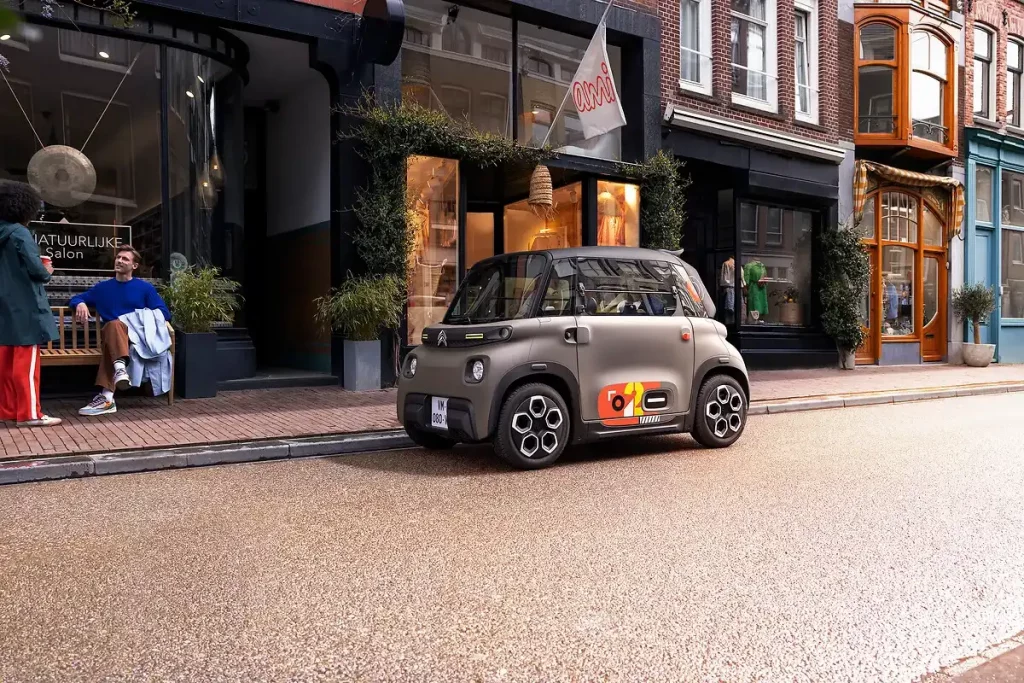
On the inside, the My Ami Peps gets a smartphone clip, orange-banded door nets, a central separation luggage net, a yellow bag hook, and three orange storage bins.
There's also orange straps and floor mat stitching.
The biggest change, however, is that the Citroen Ami Peps changes its standard colour from the grey-blue of the current model to a more green-brown colour called Night Sepia.
UK commercial vehicle manufacturing levels have fallen in May, marking the third consecutive monthly drop.
The Society of Motor Manufacturers and Traders (SMMT) reported manufacturing was down by -59.3%. The drop is thought to be due to temporary supply chain issues which impacted the number of vehicles produced.
In May, 4,400 vans, trucks, taxis, buses and coaches were manufactured.
Last May commercial vehicle manufacturing experienced a strong production month, marking the best performance since 2008. This was in response to a post Covid boom in demand and a backlog of orders which were significantly delayed as a result of supply chain disruptions due to the pandemic.
Vehicles manufactured for export made up two thirds of production in May at 68.8%. However, numbers on this front were also significantly down by -61.9% to 3,027 units.
The majority of these exports were supplied into the EU, accounting for 95.9% of exports. For the domestic market 1373 units were produced, a decline of -52.2%.
The results from the fifth month of the year now show commercial vehicle production is down for 2024 -3.2% to 45,439 units. This equates to a loss of 1,492 units. Despite a low month overall, this hasn’t dented year-to-date export figures. For 2024, exports are up by 5.9% to 31,688 units and seven in 10 commercial vehicles produced here are supplied to other countries.
Manufacturing to supply the domestic market shows a dip for this year so far. Output has declined by -19.1% which amounts to 13,751 units produced. As supply chain issues are resolved manufacturing is expected to pick up as the year progresses.
Mike Hawes, SMMT chief executive, said: “Commercial vehicle production has gone from strength to strength over the last year, driven by increasing demand at home and abroad. The recent downturn is obviously disappointing, but is temporary and, as supply chain disruptions are resolved, output should be back on track."
"With the general election now less than a week away, the next government must ensure we have the conditions necessary for growth which means maintaining favourable market conditions, improving the competitiveness of UK manufacturing and ensuring trade flows are as free and fair as possible.”
Last month (June), Stellantis UK group MD, Maria Grazia Davino warned that production at sites for electric vans in Ellesmere Port and Luton could be halted if government did not do more to promote zero emission vehicles.
UK van emissions have risen despite a growth in the number of electric vehicles on the roads.
A new study by Transport & Environment (T&E) shows van emissions in the UK have increased by 63% since 1990, contrasting with a 19% decrease in emissions from cars and taxis during the same period.
The rise in van emissions is attributed to a significant increase in the number of vans on the road, with over a million added since 2014. The majoirty of new vans added to the vehicle parque are primarily diesel-powered.
The UK government's Zero Emission Vehicle (ZEV) mandate, launched in January 2024, aims to address this by requiring a growing percentage of new van sales to be zero-emission. However, the current uptake of electric vans in the UK lags behind other European nations.
Ralph Palmer, UK Electric Vehicle and Fleets Officer at Transport and Environment, said: “The continued rise in van emissions in the UK is alarming. Despite the push for more electric vans on our roads, we are still witnessing a surge in greenhouse gas emissions from vans as a result of sustained sales of diesel vans, countering trends we are seeing in the car market. "
Palmer added: "The ZEV mandate introduced this year is an important step to increasing the supply of electric vans to the UK, but it’s clear that more action is needed to boost electric van demand among fleets to ensure we achieve the triple-win of tackling emissions, reducing running costs for small businesses, and boosting energy security."
"The new Government should bring forward plans for stronger financial support and action to improve the nation's charging infrastructure for van drivers to ensure the UK doesn’t continue to fall behind other European countries,” he continued.
A separate survey by Clean Cities indicates public support for stricter measures to tackle emissions. Nearly half of those surveyed believe the financial burden of climate action should fall on businesses, and over half support additional charges on deliveries to fund clean air initiatives.
Clean Cities is launching the Clean Cargo Capital campaign, aiming to transform Central London into a hub for zero-emission deliveries. T&E is calling for the next UK government to introduce financial incentives and improve charging infrastructure to encourage wider adoption of electric vans.
Oliver Lord, UK Head of Clean Cities, said, “There’s no way we’ll clean our air and hit our climate goals unless we do more to help businesses switch away from polluting diesel vans, which are increasing in record numbers. The share of electric vans sold in the Netherlands is twice that in the UK, which is no doubt driven by Dutch cities introducing zero emission zones for delivery and goods vehicles next year."
"Newly elected mayors and a new government offers an opportunity for the UK to get fired up and do everything it can to boost electric van sales. With greater regulatory ambition, better incentives and continued support for small businesses, there is every possibility that London could become the clean cargo capital of the world,” Lord said.
Stellantis electric van production site could be at risk, according to Stellantis UK group MD, Maria Grazia Davino.
Ellesmere Port is currently an electrification hub for production of the Citroen E-Berlingo, Fiat E-Doblo, Peugeot E-Partner and Vauxhall Combo Electric.
Speaking at the Society of Motor Manufacturers and Traders (SMMT) annual summit, Davino said the site near Liverpool as well as Vauxhall’s factory in Luton could be in jeopardy if more wasn’t done by government to increase demand for zero emission vehicles.
The decision to halt production at one or both sites could come as soon as a year.
Davino said: “Stellantis UK does not stop, but Stellantis production in the UK could stop.”
Electric van production is due to start in Luton next year when it will make the medium sized electric vans in the group which include the Citroen E-Dispatch, Fiat E-Scudo, Peugeot E-Expert and Vauxhall Vivaro Electric.
“We have undertaken big investments in Ellesmere Port and in Luton, with more to come. If this market becomes hostile to us, we will enter an evaluation for producing elsewhere,” Davino explained.
The UK government has set a goal to ban sales of new petrol and diesel cars by 2035 - initially their plan was to introduce the ban in 2030.
With all parties currently on the campaign trail ahead of the 4 July general election, key climate change messages and how future governments will tackle them have become an important manifesto element.
Increasing threats from the EU to impose tariffs on Chinese built vehicles is also causing unrest in the industry.
After an EU indication that costly tariffs could be imposed on Chinese manufacturers - that would include Maxus and models including the recently launched Maxus eDeliver 5 and Maxus eDeliver 7 - several European manufacturers chastised the idea, including global Stellantis boss Carlos Tavares.
Vauxhall has announced a new scheme to encourage businesses to switch to electric vans. The offer makes the Vauxhall Combo Electric available on business lease for the same monthly cost as its diesel counterpart, the Vauxhal Combo, with identical deposit and contract terms.
Businesses can lease the Combo Electric in its base "Prime" trim for £329 per month with a £1,974 deposit, or upgrade to the "Pro" trim for £365 per month with a £2,190 deposit.
Both options come with a 60-month lease agreement and a mileage allowance of 6,000 miles per year.
Vauxhall estimates that businesses can save around £91 per month by switching to the electric Combo. This includes fuel cost savings of roughly £64 per month (based on 500 miles driven monthly) and savings of £26 per month due to the current exemption on road tax for electric vehicles.
Businesses in London's Ultra Low Emission Zone (ULEZ) will also benefit from a £9,500 scrappage grant by replacing a non-compliant diesel van with the Combo Electric.
On top of the offer there's also a three-year roadside assistance plan and an eight-year warranty on the Combo Electric's battery.
This new offer coincides with Vauxhall's recent "Energising a Better Britain" campaign, highlighting their range of electric light commercial vehicles (e-LCVs).
Vauxhall currently offers electric versions of all their LCV models, which includes Vauxhall Vivaro Electric and Vauxhall Movano Electric. Vauxhall has been the UK's best-selling electric van manufacturer for the past three years (2021, 2022, and 2023) and is currently producing the Combo Electric at Vauxhall's Ellesmere Port plant.
Production of electric vans is scheduled to begin at Vauxhall's Luton plant next year, however, Stellantis UK group MD, Maria Grazia Davino, has cast doubt on the future of both Stellantis plants in the UK.
Renault has upgraded the specification and trim levels of its Renault Kangoo E-Tech electric van.
Thew revamped Kangoo E-Tech gets a new front grille design as well as upgrades that include an electric parking brake, colour driver information display, rear parking camera, intelligent speed assist and automatic high beam assist.
There's also upgraded safety equipment including driver, passenger, lateral and curtain airbags, as well as driver attention and drowsiness warning, and intelligent speed assist.
Along with enhancements to the line-up, all of which will be standard on new models produced from July this year, the Kangoo range has also had a price cut.
The Renault Kangoo range will now start from £20,250 (ex VAT), while the electric Kangoo E-Tech price has been lowered by up to £2,500 depending on model. The cheapest electric Kangoo now starts at just £27,350 plus VAT after the Plug In Van Grant (PiVG).
Advance standard equipment
· 16-inch flex wheels
· Nearside and Offside sliding Loading Doors - Unglazed
· Rear Doors - Unglazed, 180° opening
· Black door handles
· Roof Bar Fixings
· Non-body coloured side mirrors
· Door Mirrors - Heated with Electric Adjustment
· Automatic headlights and rain sensitive front wipers
· Automatic high beam assist
· 4.2-inch colour TFT driver information display
· EASY LINK display with 8-inch touchscreen, DAB radio, Bluetooth and USB ports
· Smartphone integration with Android Auto and Apple CarPlay
· Electric front windows - driver's side 'one touch' descending
· Manual Air Conditioning
· New Kangoo Cloth Upholstery with Yellow Accents
· Overhead Storage
· Passenger sun visor with mirror
· Driver's Seat - Height Adjustable
· Single Passenger Seat
· Closed Glovebox
· Full Bulkhead
· 12v Power Socket (Front)
· Electric Parking Brake
· 10 Anchorage Points in Load Area
· LED Lighting - Load Area
· Driver and passenger front airbags plus
· Airbag - front lateral, curtain and front passenger with deactivation
· Cruise Control and Speed Limiter
· Intelligent speed assist - overspeed prevention and traffic sign recognition
· Rear parking camera
· Reverse Parking Sensors
· Hill Start Assist
· E-Call - automated emergency call
· Seatbelt reminder Driver and passenger
· Wide View Mirror
· Active Emergency Braking System (Urban + City + Pedestrian + Cycle)
· Driver attention and drowsiness warning
· Lane Departure Warning
· Deadlocking and Thatcham T1 Volumetric Alarm
· Tyre pressure monitor and Tyre Repair Kit (in place of Spare Wheel)
Advance Crew Van (in addition to Advance)
· 16-inch Steel Wheel Trims
· New Kangoo Fabric Upholstery
· Auto dimming rear view mirror
· Second row seating converting into bulkhead
· Second row of three Passenger Seats with Headrests
· Interior Side Panels up to Windows
· Nearside and Offside Loading Doors – Glazed
Advance E-Tech (in addition to Advance)
· 16-inch Steel Wheel Trims
· Automatic Monozone Air Conditioning with heat pump
· Front E-Tech Charging Port
· Mode 3 Type 2 AC Charging Cable
· Z.E. Voice - Vehicle sound under 18mph
· Brake energy regeneration mode
Extra (in addition to Advance)
· 16-inch alloy wheels (only available on LWB versions)
· LED headlights with daytime running lights
· LED indicators
· Front fog lights
· Body-coloured bumpers
· Door mirrors - electric folding
· Body-coloured door handles
· Body-coloured side rails
· Glossy black side mirrors
· Hands-free key card with keyless start, approach unlock, walk away closure
· EASY LINK navigation with 8-inch touchscreen, DAB radio, Bluetooth and USB ports
· Passenger Bench Seat - with mobile office
· Blind spot intervention
· 360° degree parking sensors
The UK light commercial vehicle market has maintained its positive trajectory, registering its 17th consecutive month of growth during May.
The latest data from the Society of Motor Manufacturers and Traders (SMMT) shows a 1.9% increase in registrations, reaching 25,853 units for the year to date.
This is the strongest May performance since 2021, a year marked by historically high business investment in commercial vehicles following the Covid pandemic.
Medium vans weighing between 2 tonnes and 2.5 tonnes saw the most significant rise (up 8.1%), while small vans under 2 tonnes experienced the highest proportional growth (55.7%).
The 4x4 market, also susceptible to wild fluctuations due to the very small sales volumes, declined by 15.0%, while pick-up trucks witnessed a modest increase of 4.1%.
As ever, large vans exceeding 2.5t but under 3.5t dominated the market (65.9%), though they registered a slight decrease of 0.8%.
Despite the overall positive outlook, the transition towards electric vans falls short of expectations.
Battery electric van (BEV) registrations grew 3.5% in May, capturing a 4.2% market share.
This marginal increase maintains near parity with the 2023 figure of 4.1%. Even more concerning, year-to-date BEV uptake has dipped slightly to 4.8% market share, down from 5.2%.
Mike Hawes, SMMT Chief Executive, said, “The UK van market’s 17-month run of growth is playing a crucial part in renewing the fleet with the latest, cleanest vehicles. However, convincing businesses that now is the time to switch to zero emission operations remains a challenge. With an expanding choice for every use case now available, the next government must take steps to recharge the zero emission van market, an essential part of the net zero economy every party wants.”
| Rank | Model | May 2024 |
| 1 | Ford Transit Custom | 3,189 |
| 2 | Ford Transit | 2,505 |
| 3 | Ford Ranger | 2,130 |
| 4 | Renault Trafic | 1,358 |
| 5 | Volkswagen Transporter | 1,265 |
| 6 | Mercedes-Benz Sprinter | 1,148 |
| 7 | Ford Transit Connect | 1,013 |
| 8 | Peugeot Partner | 855 |
| 9 | Vauxhall Vivaro | 827 |
| 10 | Citroën Berlingo | 789 |
| Rank | Model | Year-to-Date |
| 1 | Ford Transit Custom | 17,185 |
| 2 | Ford Transit | 13,253 |
| 3 | Ford Ranger | 8,652 |
| 4 | Vauxhall Vivaro | 7,250 |
| 5 | Volkswagen Transporter | 7,208 |
| 6 | Mercedes-Benz Sprinter | 7,002 |
| 7 | Ford Transit Connect | 5,659 |
| 8 | Renault Trafic | 5,242 |
| 9 | Citroën Berlingo | 4,485 |